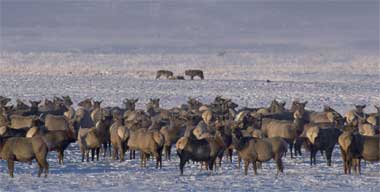UC Berkeley Press Release
 Scavenger birds wait their turn to share in a wolf's meal. UC Berkeley research says that wolves help buffer the impact of climate change by sharing their leftovers with scavengers. (Photos by Dan Hartman) |
Wolves alleviate impact of climate change on food supply, finds new study
BERKELEY – Yellowstone National Park's gray wolves, once nearly extinct there, have returned to play a critical role in easing the effects of climate change on food availability, according to a new study by researchers at the University of California, Berkeley.
When winters are severe, more elk die, providing needed food for the wide range of scavengers in the area, including bears, coyotes, eagles and ravens, the researchers said. Shorter, warmer winters brought on by global warming increase the survival rate of elk, causing a food shortage for the scavengers at a time when other resources are scarce.
With the help of the gray wolves, however, elk are regularly killed off regardless of the winter's severity, according to the study. And luckily for the scavengers, the wolves are willing to share their leftovers, thereby buffering the impact of climate change.
 Elk huddle together vigilantly as wolves dine on one of their comrades in the distance. |
"When wolves are around, you no longer get this boom-bust cycle in carrion availability," said the study's lead author, Chris Wilmers, who conducted his work as a Ph.D. student in ecosystem sciences at UC Berkeley's College of Natural Resources. "Wolves provide a steady supply of carrion for the scavengers throughout the winter, whether it is mild or severe."
Gray wolves were once found throughout North America, but were nearly hunted to extinction by 1970. Since the U.S. Fish & Wildlife Service reintroduced wolves to Yellowstone in 1995, a growing body of research is finding that this top carnivore, which has been making a comeback, is an essential player in the region's ecosystem. There are now 31 gray wolves at Yellowstone.
The new study, which appears in the April 2005 issue of the online journal Public Library of Science Biology, builds upon earlier research led by Wilmers. The earlier studies found that wolves, unlike other predators, leave behind their kill once they've stuffed themselves, allowing scavengers to partake in the bounty.
In contrast, other predators, including grizzly bears and mountain lions, will either guard or hide their kills from scavengers.
Wilmers, who now holds a post-doctoral researcher appointment at Pennsylvania State University, noted that some scavengers have adapted their behavior to take advantage of the wolves' idiosyncrasy. "Ravens have adopted a foraging strategy by following the wolves when they are on a hunt," said Wilmers. "When wolves chase down their prey through wide open spaces over long distances, it's as good as a dinner bell. Ravens and other scavengers know that a meal is coming."
The study adds a new twist to the wolves' ability to provide food for other animals. It highlights both the effects of global warming on Yellowstone's ecosystem and the importance of the wolf in helping animals cope with the climate change.
"Few studies have really looked at the impact of global warming on a whole food chain," said Wayne Getz, UC Berkeley professor of environmental science, policy and management and co-author of the study. "We're finding that ecosystems that have lost a keystone predator may exhibit less resilience to the impact of climate change. Because wolves ameliorate the effect of weather, the scavenger community will be better able to adapt to changing conditions."
The researchers studied 55 years of weather data from Yellowstone's Mammoth Hot Springs and Tower Falls stations. Information on average monthly snow depths and maximum temperatures revealed any trends in climate over the decades.
They found that while the onset of winter did not change significantly over the decades, snow depths did decline significantly in late winter, particularly after February. At the same time, the number of days where maximum temperatures reached above freezing increased significantly, with the most pronounced differences also found in the late winter months.
Using statistical models, the researchers calculated that in scenarios where wolves are absent, carrion availability is reduced by 27 percent in March and by 66 percent in April. When wolves are around, however, the availability of carrion is only reduced by 4 percent in March and 11 percent in April.
In neither scenario did the presence of wolves have a significant impact on the availability of carrion during the early and mid-winter months, when food shortage was not a factor.
"The results really show that an intact ecosystem is better able to adapt to the effects of climate change than one that has been disrupted by the removal of a major element in the food chain," said Wilmers.
An Environmental Protection Agency Science to Achieve Results fellowship supported Wilmers' research. Funding for the study also came from a James S. McDonnell Foundation Twenty-First Century Science Initiative Study of Complex Systems Award to Getz.

